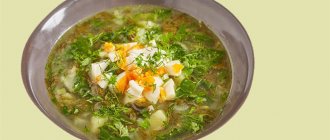- July 27, 2018
- Diets
- Irina Voloshina
Scrambled eggs are a hearty and healthy dish. Also, its great advantage is the simplicity and speed of preparation. That is why it is rightfully one of the most popular and favorite breakfasts.

This meal allows you to maintain a feeling of fullness for a long time, and the calorie content of scrambled eggs from 2 eggs will not harm your figure.
Nutritional value and benefits of eggs
Chicken eggs are a source of antioxidants, microelements, healthy fatty acids, nutrients, vitamins and protein.
Minerals contained in chicken eggs:
- sodium;
- fluorine;
- calcium;
- potassium
- phosphorus;
- zinc.
Thanks to vitamins A, E, D, B6, B12, important processes are established in the body:
- metabolism is activated;
- favorable conditions are created for the synthesis of hemoglobin and insulin;
- stimulates the formation and growth of new cells;
- the aging process slows down;
- the functioning of the immune system improves.
Benefit or harm
Many people regularly cook omelettes, scrambled eggs, and other egg-based dishes. Such products can cause harm to health if:
- consumption in too large quantities;
- violations of storage conditions and preparation rules;
- presence of personal contraindications.
Eggs contain a lot of protein, so they are included in the diet of athletes and people who follow a low-carbohydrate diet. The product, rich in vitamins and microelements, replenishes the supply of nutrients in adults and prevents the development of vitamin deficiency in children.
If the goal is not to achieve a certain amount of protein in the diet, you should not eat egg dishes every day. It is enough to cook them a couple of times a week.
Few people have the willpower to get up early in the morning and make a full breakfast. Many people are content with a dish that takes five minutes to prepare. It is clear that we are talking about fried eggs. But won't consuming it lead to extra pounds? We'll find out if we count how many calories are in a scrambled egg made from two eggs.
How many eggs can you eat a day?
Despite the many beneficial properties, you need to know when to eat eggs in moderation. An excess, as well as a complete refusal of this product, can have a bad effect on human health.
But moderate consumption is recommended for any person if there is no allergy to eggs or liver disease.
- If you have high blood cholesterol levels, it is recommended to eat no more than 3 eggs per week.
- Normal cholesterol levels require eating one or two eggs per day. This figure can be increased slightly if there are no other foods containing eggs in the diet (for example, baked goods).
- Eggs can be introduced into children's diets from 10–12 months. In this case, only the yolk is consumed, no more than 1 piece per week. Protein should not be consumed so as not to cause diathesis in the child.

- Then you can gradually increase the amount of product: from 1.5 years, one egg per week, from three years - up to 3 eggs per week, from 6 years - no more than 5-6 pieces weekly.
Contraindications for eating eggs
This product is one of the most healthy and low-allergenic (provided that chickens are raised organically without the use of chemical food additives). However, there are a number of contraindications for eating eggs and dishes made from them.
The main ones:
- Overweight.
- Diseases of the blood and blood vessels, atherosclerosis.
- High blood pressure.
- Diabetes.
- Cholecystitis and liver diseases.
- Disturbances in the gastrointestinal tract.
If you suffer from one of these diseases, you should only eat egg whites.
Calorie content of scrambled eggs
The energy value and calorie content of a dish depend on the amount of ingredients and the method of their preparation. The simplest version of scrambled eggs consists of eggs and vegetable oil.
- The weight of one chicken egg is about 65–70 grams. Its calorie content is about 110 kcal.
- To prepare one egg, an average of 5 ml of oil is consumed, with a calorie content of about 40 kcal.
- Thus, you can determine how much a scrambled egg weighs from 1 egg: 65 + 5 = 70 grams. The energy value will be 150 kcal.
Based on these data, you can calculate how much a scrambled egg from 2 eggs weighs. It is important to consider that the amount of oil may remain the same. It doesn't have to be increased by adding one or two eggs to the scrambled eggs.
Then the calorie content of scrambled eggs from 2 eggs in sunflower oil will be: 110 + 110 + 40 = 260 kcal.

Calculations are made using the same principle for scrambled eggs of three eggs. But it should be borne in mind that breakfast usually accounts for about 500 kcal of the total daily requirement. Therefore, you can independently adjust the calorie content of scrambled eggs, taking into account individual needs, especially if the dish contains additional ingredients.
Dietary recipes
To ensure that fried eggs contain fewer calories, you need to cook them without butter or other fats. This will also reduce the amount of cholesterol you consume with this dish. By excluding fried oil, you do another benefit to your body: you rid it of carcinogens contained in thermally processed fat. But if you don’t have the opportunity to cook fried eggs in another way, make sure that there is as little oil in the pan as possible.
The healthiest version of fried eggs is considered to be a dish without any salt or with a minimal amount of it. Instead of salt, you can add finely chopped herbs (parsley, spinach, dill), spices or kelp powder.
To make fried eggs without oil in the oven, you can use silicone molds or a regular frying pan. Cooking time: up to 15 minutes at 180 degrees. No fat is required for baking. If you are afraid that the fried egg will stick, you can lightly spray the surface of the pan with fat.
If you need to get rid of extra calories or cholesterol, make scrambled eggs only from whites. In terms of energy value, they are inferior to yolks, so to fill them up, add meat or fish, vegetables, and legumes. This dish is recommended for athletes and anyone who wants to improve their figure through physical exercise.
The value of eggs as a dietary product is difficult to exaggerate. They help us retain much-needed proteins during a diet, quickly fill us up and promote weight loss. But you need to prepare this product correctly: extra fats and calories will not increase the benefits of consuming fried eggs.
Calorie content of 2 egg omelet with milk, How many calories in 2 egg omelet with milk
The main ingredients for an omelet are traditional eggs and milk, and as for other products sometimes used, it depends on the preferences and tastes of the person for whom this dish is intended.
Omelette cooks very quickly, so it is often made for breakfast. But many people who care about their figure are interested in how much its use will affect it.
1. Calorie content of an omelet made from 2 eggs with milk
The calorie content of an omelet made from 2 eggs with milk in one serving (167 grams) is 239 kcal.
100 g of product contains
- 15.4 g protein,
- 17.7 g fat,
- 3.1 g carbohydrates.
Calorie content is indicated for a dish of 2 eggs, 5 ml of sunflower oil, 2 g of salt and 50 ml of 1.5 percent milk.
2. How many calories are in an omelette without yolk?
An omelette with vegetables without yolks (100 g) contains:
- Proteins – 7.6 g;
- Fat – 8.2 g;
- Carbohydrates – 2.6 g;
- The calorie content of the product is 111 kcal.
For many people, such an omelet recipe loses its taste, but the choice is up to the consumer: either food with less calories, or the taste of the product. In an omelet with vegetables, the absence of yolks in the product will not be so noticeable, since each vegetable brings its own individual “notes” to the dish.
3. Calorie content of omelette with cheese
The calorie content of an omelet with cheese per 100 grams is 158 kcal.
Per 100 g of product
- 13.9 g protein,
- 11 g fat,
- 0.8 g carbohydrates.
4. Calorie content of omelette with tomatoes per 100 grams
The calorie content of an omelet with tomatoes per 100 grams is 152 kcal.
100 g of product contains
- 7.1 g protein,
- 12.6 g fat,
- 1.9 g carbohydrates.
1 ready-made 130-gram serving of the dish contains 196 kcal,
- 9.2 g protein,
- 16.3 g fat,
- 2.5 g carbohydrates.
Calorie content of scrambled eggs with additional ingredients
Often other products are added to scrambled eggs. This helps improve the taste of the dish and make the diet more varied. Depending on which product was added, the calorie content of the entire dish will greatly change.
You can consider the example of scrambled eggs with tomatoes. This vegetable can be found in almost any housewife’s home and goes well with eggs.
The weight of one medium-sized tomato will be about 50 grams, and the calorie content is about 9 kcal.
The calorie content of scrambled eggs for 2 eggs with tomatoes can be calculated: 220 (2 eggs) + 40 (butter) + 9 (tomato) = 269 kcal.

So, the nutritional value of the dish per 100 grams was 193 kcal. And after adding tomatoes, the figure changed: 145 kcal per 100 grams.
It should be noted that in this way you can not only reduce, but also increase the calorie content of scrambled eggs by 2 eggs. It all depends on the added components.
Several arguments in defense of the "poor man's dish"

In the old days, scrambled eggs were considered too simple a food; they were served in low-income families. In the “biography” of this food there were periods when it was stigmatized due to the presence of cholesterol. Now nutritionists are vying with each other to praise its dietary properties and declare that it must be present in the diet. After all, it turned out that the cholesterol in it is not harmful, but is full of valuable microelements. It is impossible to gain weight from eggs, but improving your mental abilities is quite possible!
For those losing weight, the following information will be useful:
- scrambled eggs themselves do not belong to the category of high-calorie dishes (167 energy units is a mere trifle!);
- when using it, you need to know when to stop;
- if the calorie problem is very acute, stop eating the yolk;
- When deciding whether to include it in the menu, remember that one of the most high-calorie food components is oil. In creamy - 748 kcal, in vegetable - up to 899. Therefore, by preparing fried eggs using them, you automatically add 90 kcal to yourself. And the daily calorie limit for a lady of average height who has decided to lose weight is 700-1400 kcal. So take the Teflon-coated frying pan out of the cupboard.
How to diversify your scrambled egg recipes?
Despite its simplicity, scrambled eggs have many cooking options. For variety, you can add not only tomatoes, but also other vegetables: bell peppers, zucchini, spinach, asparagus, eggplant, onions or frozen vegetable mixtures.
A dish of eggs with mushrooms will be tasty and healthy. They are also a source of protein and low in calories.
You can add cheese and herbs to taste to almost any scrambled egg.
Scrambled eggs with the addition of animal fats, bacon or sausage have the highest calorie content.

You can also alternate cooking fried eggs or scrambled eggs.
Low calorie omelette
Such a dietary dish is quite possible if you prepare it correctly. First of all, it is better not to fry the omelet: fried eggs contain carcinogens that have a negative effect on the liver. And they, like the fats contained in oil, lead to weight gain.
It is advisable to cook an omelet in a slow cooker or double boiler.
It makes sense not to use the yolks:
One hundred grams of omelette with whites alone contains only 85 kcal.
Greens also reduce energy value: parsley, basil, dill help the digestive system and are excellent aids in the fight against fat deposits.
Calorie content depending on cooking method
Due to the evaporation of water during the frying process, the specific gravity of the product decreases, so the calorie content per 100 grams increases. In 100 grams of scrambled eggs, cooked without oil in a non-stick frying pan, there will be not 158 kcal, as in raw form, but already 170 kcal. That is, a serving of two fried eggs without fat will contain on average 250-260 kcal.
Frying with added fat will increase the nutritional value of each serving by the corresponding amount of kcal:
- butter – per 100 kcal (15 g);
- sunflower oil – 45 kcal (5 g);
- low-calorie margarine – 85 kcal (15 g);
- melted lard – 135 kcal (15 g).
Recommendations for cooking scrambled eggs
For the most accurate calculations, the size of the eggs should be taken into account. If they turn out to be small in size, then the weight of one piece will be about 55–60 grams, and the nutritional value will be 85 kcal.
Accordingly, the calorie content of scrambled eggs changes by 2 eggs.
To prepare a tasty and healthy breakfast, you should use the following recommendations:
- Use only fresh eggs, especially if the recipe calls for the yolk to be runny.
- If desired, you can increase the portion of vegetables and reduce the number of eggs.
- You can serve scrambled eggs with fresh vegetables; it’s delicious and will help enrich your diet with fiber.
- You can reduce the calorie content of scrambled eggs by 2 eggs by eliminating the oil in the recipe. A non-stick frying pan is suitable for this.
- You can reduce the amount of oil or completely eliminate it when cooking scrambled eggs in the microwave or oven.
Scrambled eggs are not only a great breakfast, but can also be a complete meal at any time.
Source: tony.ru
Ingredients scrambled eggs from 2 eggs in sunflower oil.
scrambled eggs from 2 eggs in sunflower oil.
Nutritional value and chemical composition of “scrambled eggs from 2 eggs in sunflower oil.”.
| Nutrient | Quantity | Norm** | % of the norm in 100 g | % of the norm in 100 kcal | 100% normal |
| Calorie content | 199.6 kcal | 1684 kcal | 11.9% | 6% | 844 g |
| Squirrels | 14 g | 76 g | 18.4% | 9.2% | 543 g |
| Fats | 15.6 g | 56 g | 27.9% | 14% | 359 g |
| Carbohydrates | 0.8 g | 219 g | 0.4% | 0.2% | 27375 g |
| Water | 67.2 g | 2273 g | 3% | 1.5% | 3382 g |
| Ash | 1.341 g | ||||
| beta carotene | 0.06 mg | 5 mg | 1.2% | 0.6% | 8333 g |
| Vitamin B1, thiamine | 0.077 mg | 1.5 mg | 5.1% | 2.6% | 1948 |
| Vitamin B2, riboflavin | 0.487 mg | 1.8 mg | 27.1% | 13.6% | 370 g |
| Vitamin B4, choline | 277.58 mg | 500 mg | 55.5% | 27.8% | 180 g |
| Vitamin B5, pantothenic | 1.438 mg | 5 mg | 28.8% | 14.4% | 348 g |
| Vitamin B6, pyridoxine | 0.155 mg | 2 mg | 7.8% | 3.9% | 1290 g |
| Vitamin B9, folates | 7.741 mcg | 400 mcg | 1.9% | 1% | 5167 g |
| Vitamin B12, cobalamin | 0.575 mcg | 3 mcg | 19.2% | 9.6% | 522 g |
| Vitamin D, calciferol | 2.433 mcg | 10 mcg | 24.3% | 12.2% | 411 g |
| Vitamin E, alpha tocopherol, TE | 2.216 mg | 15 mg | 14.8% | 7.4% | 677 g |
| Vitamin H, biotin | 22.339 mcg | 50 mcg | 44.7% | 22.4% | 224 g |
| Vitamin K, phylloquinone | 0.3 mcg | 120 mcg | 0.3% | 0.2% | 40000 g |
| Vitamin RR, NE | 3.9812 mg | 20 mg | 19.9% | 10% | 502 g |
| Niacin | 0.21 mg | ||||
| Macronutrients | |||||
| Potassium, K | 154.84 mg | 2500 mg | 6.2% | 3.1% | 1615 g |
| Calcium, Ca | 61.69 mg | 1000 mg | 6.2% | 3.1% | 1621 g |
| Magnesium, Mg | 13.32 mg | 400 mg | 3.3% | 1.7% | 3003 g |
| Sodium, Na | 239.27 mg | 1300 mg | 18.4% | 9.2% | 543 g |
| Sera, S | 195.06 mg | 1000 mg | 19.5% | 9.8% | 513 g |
| Phosphorus, Ph | 212.6 mg | 800 mg | 26.6% | 13.3% | 376 g |
| Chlorine, Cl | 312.96 mg | 2300 mg | 13.6% | 6.8% | 735 g |
| Microelements | |||||
| Iron, Fe | 2.772 mg | 18 mg | 15.4% | 7.7% | 649 g |
| Yod, I | 22.12 mcg | 150 mcg | 14.7% | 7.4% | 678 g |
| Cobalt, Co | 11.094 mcg | 10 mcg | 110.9% | 55.6% | 90 g |
| Manganese, Mn | 0.0327 mg | 2 mg | 1.6% | 0.8% | 6116 g |
| Copper, Cu | 92.43 mcg | 1000 mcg | 9.2% | 4.6% | 1082 g |
| Molybdenum, Mo | 6.894 mcg | 70 mcg | 9.8% | 4.9% | 1015 g |
| Selenium, Se | 35.056 mcg | 55 mcg | 63.7% | 31.9% | 157 g |
| Fluorine, F | 60.82 mcg | 4000 mcg | 1.5% | 0.8% | 6577 g |
| Chromium, Cr | 4.42 mcg | 50 mcg | 8.8% | 4.4% | 1131 g |
| Zinc, Zn | 1.2289 mg | 12 mg | 10.2% | 5.1% | 976 g |
| Digestible carbohydrates | |||||
| Mono- and disaccharides (sugars) | 0.8 g | max 100 g | |||
| Essential amino acids | |||||
| Arginine* | 0.874 g | ||||
| Omega-3 fatty acids | 0.1 g | from 0.9 to 3.7 g | 11.1% | 5.6% | |
| Omega-6 fatty acids | 1.3 g | from 4.7 to 16.8 g | 27.7% | 13.9% |
Energy value of scrambled eggs from 2 eggs in sunflower oil. is 199.6 kcal.
Primary Source: Created in the application by the user. Read more.
** This table shows the average levels of vitamins and minerals for an adult. If you want to know the norms taking into account your gender, age and other factors, then use the “My Healthy Diet” application.
Useful properties of eggs
Several years ago, people tried not to eat eggs at all, as scientists discovered they contained high levels of cholesterol. But experts completely forgot about the fact that eggs are an irreplaceable source of lecithin, a substance that prevents cholesterol from being deposited on the walls of blood vessels in the form of plaques. As soon as such information reached people, the attitude towards this food product immediately changed. Now they are considered the most useful product of our time, and doctors recommend eating at least one egg per day.
An egg consists of white and yolk, and its uniqueness lies in the fact that it contains almost all microelements and macroelements, as well as four more important chemical elements - carbon, oxygen, nitrogen and hydrogen, which make up organic substances, in other words, more than fifty bioelements in total. This number of useful substances is understandable, because eggs are created by nature to provide chicken embryos with everything vital.
Chicken yolk contains most of the water-soluble vitamins, fat-soluble vitamins, and the main reserves of minerals. Eighty percent of all phosphorus and most of the magnesium, iron, calcium, potassium, chlorine, sodium and sulfur are found here. Egg yolk is rich in lipids, proteins, minerals, and vitamins. The lecithin it contains nourishes brain and nerve tissue. It is needed for the normal functioning of the biliary tract and liver, regulates the distribution of adipose tissue, and is also responsible for the development of the fetus during pregnancy and improves memory. Vitamin E and iron contained in the yolk help a person fight bad mood and fatigue, and prevent the development of cardiovascular diseases. The combination of phosphorus and vitamin D in the yolk makes bones and teeth healthy.
In addition to minerals and vitamins, egg yolk contains carotenoids. Important among them are vitamin A and beta-carotene. They reduce the development of cataracts. The more carotenoids in the yolk, the more saturated the color of the yolk.
Egg white contains minerals, carbohydrates, protein and various amino acids that the human body cannot synthesize on its own. Without animal protein, new cells will not be formed and renewed.
Egg whites are a low-calorie source of complete proteins. One hundred grams of egg white contains 45 kcal and 11 g of protein. Chicken protein is the standard of biological value for humans due to its amino acid composition, as well as almost complete digestibility.
The calorie content of an egg depends on many factors. First of all, it depends on the size. A standard chicken egg weighs seventy grams. One hundred grams of egg contains approximately one hundred and sixty kilocalories. By simple calculations you can obtain the energy value of one egg. Not only weight affects the calorie content of an egg. It all depends on how exactly a person prepares eggs. The most high-calorie foods are fried eggs. One hundred grams of fried eggs contains one hundred twenty-five kcal.
A hard-boiled egg contains fifty calories per hundred grams of product, and a soft-boiled egg contains seventy calories. Moreover, an interesting fact is that boiled eggs have no cholesterol at all; it is destroyed under the influence of temperature. If you fry only the whites, the calorie content of the dish will decrease, because the number of carbohydrates in the protein is minimal, and unlike the yolk, there is no fat at all.








